Learning to feed yourself in the forest can be one of the most terrifying things. Am I about to give myself food poisoning? Is this berry safe? How can I stay full without carrying anything? Oh god, was this supposed to be refrigerated?
With Ode to My Pack Sack, learn to pack for A-Camp without having a meltdown on the shuttle. Give a man a fish and feed him for a day, give a queer a granola bar and stave off malnutrition until you make it back to civilization.
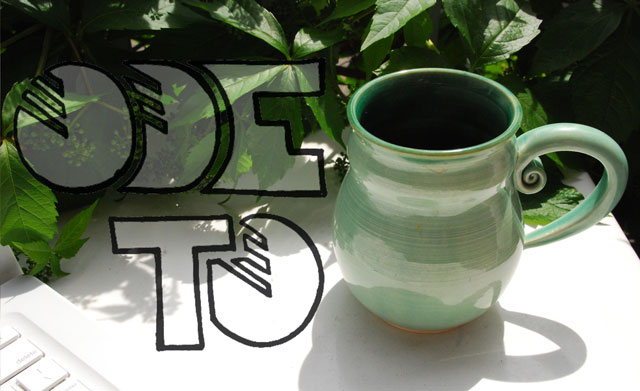
Is there anything better than a warm cuppa joe to wake you up? Sure, I could chug a pre-dawn Red Bull or cola or find some other type of caffeine delivery system, but carbonation’s hard to deal with when you haven’t brushed your teeth and Wake Me Up Wrigley’s is still a pipe dream. Let’s face it, six and a half out of ten sleep deprived humans agree with me with me when it comes to warm cuppas and I succumb to peer pressure.
When I originally started writing this, I was sitting in my apartment with electricity and stovetops up the wazoo (three ovens?) and too many coffee makers to think about. Keurigs? Moka pots? Espresso machines? Sending my roomie to our local Greek cafe? How the fuck do you make a decision when your brain’s still set to snooze? But then I went to A-Camp and saw the caffeine delivery systems people actually brought and it cut through the sleep (and writer’s block)-induced haze. So for this round of Caffeination Station, we’re going to stick to packable and portable delivery systems that require little more than hot water. Iced coffee and Fancy Machines I Cannot Afford will wait for another day.
(Warning: I taste tested my way to cup five, so I’m really long-winded today.)
The Bean

The story behind the brown bean brew involves high goats and shepherds with braver tongues than me. If you’re caffeinated enough to make it through 480 pages, you should read it. But if you don’t have the power to open your eyes for that long, let’s just get down to business. We’re not interested in the berry (unlike the poop coffee civet), simply the bean. If you were to drink the beans seeds in their raw state, you’d find they taste vegetal and bland, something more akin to raw split pea water than a luxurious morning drink. But give those greenies a roast and they develop those familiar caramel, acidic, vanilla, spicy and nutty notes.
In addition to these new flavours, they also produce new gases! The beans puff up like tiny popcorn kernels full of carbon dioxide! That oily foam that forms when your grounds meet water? Those are carbon dioxide-fuelled bubbles right there, proving that the beans held onto their gas. Post-roast, beans expel tons of gas and if you closed them up tight they’d explode before they ever got to market. So roasters often employ one-way belly buttons to keep oxidizing air out and release the outgassed CO2. If you want to keep your beans fresh, keep that packaging intact or double bag it if you’re paranoid. But if you received an unsealed bag, get those beans into an air-tight container ASAP so your cuppa doesn’t taste like wasted paycheques and regret.
The Grind
If you were to stick your beans straight into water, you’d end up with a hot cup of floating bean water (don’t lie to me and pretend you haven’t done this). You’d get some caffeine and flavour, but not nearly enough to keep you awake or convince you to do it again. By grinding the beans, more surface area is exposed so your solvent can liberate tasty things. But grind it to fine (or leave it too long) and the water will overextract, letting bitter phenolic compounds and browning pigments crash the party. There’s a reason people are finnicky about their grinders.
Burr wheel grinders force beans through two interlocking cones or wheels held a chosen distance apart. When you turn the crank or plug it in, the beans are continuously smashed until they fit through the cracks. Imagine using a disher to portion out muffin batter, that’s how similarly sized your coffee shards will be. So when you add your water, you can be reassured that most pieces will be done at the same time, releasing the tasty compounds and keeping the bitter ones locked in. Cee favoured a Kyosera and Melisa favoured a Hario.
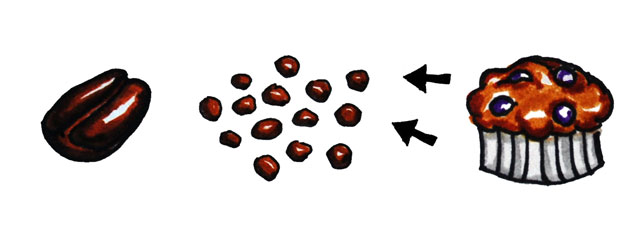
On the other hand, blade grinders whip your beans around until you stop turning. There’s little control over the final size, so some pieces will be crushed to dust whereas other chunks stay intact. If we’re continuing with the muffin analogy, imagine filling up your pan willy nilly, overflowing some holes and barely filling others. If you steeped your coffee so the average particle is done, some pieces would be oversteeped (burnt) whereas others would be understeeped (raw). That’s crazy talk.
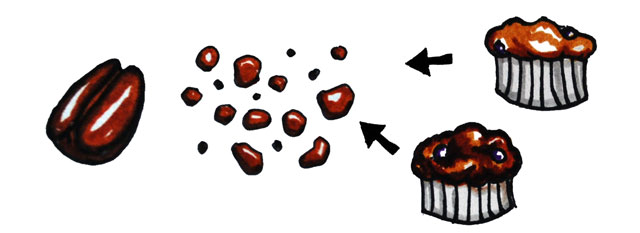
Keep in mind that you could always get your coffee ground when you buy it, it’ll just go stale a lot faster since so much surface area is exposed. But if you’re doing a short trip and know you’ll go through the coffee lickety split, get it ground so you don’t have to deal with floating bean water when you’re debating if you should bring a grinder or your head lamp.
Got the Skerton just a few weeks ago when my friend Tim kept making me fantastic cups of coffee using this magical machine (I had the same coffee grounds at home, but it didn’t taste as good). Conical burrs (which the Skerton has) produce a more consistent grind compared to traditional metal rotating blades, and the coarseness settings are fairly easy to adjust. Great manual burr grinder that’s reasonably priced and portable. – Melisa
Gravity Methods

When it comes to office coffee, people often complain that it’s too fucking weak. But don’t blame the drip method, blame the underheated water, oxidized coffee or stingy portions! Pour over is the same thing, but with some added control. You can get a Melitta like Christie and Potter or a Clever Coffee Dripper like Ali, but the idea is the same: a cone with a hole in it. The water percolates through the grounds, making a quick extraction before it drips out the bottom. Clean up is as simple as tossing out the filter. (Stay away from the fancy-pants Hario since ceramic is a bitch to pack.)
Since you’re at gravity’s mercy, you’re more likely to under than overbrew. If you want a thicker cuppa, do all that you can to increase the Water-Coffee Sexy Times.
- Get the water close to a boil (195-205°F or 91-96°C) since a hotter solvent is a better solvent and grind your coffee medium to fine (but not so fine that it’ll get through your filter).
- Use more grounds! The water will have to move through More Stuff so it’ll increase the extraction time.
- Instead of dumping your water all at once, wet your grounds in stages so it holds onto the water. The first pour should saturate everything and then the subsequent pours (or spirals or loops) will extract from different areas, so every coffee chunk gets the opportunity to release its flavour and live up to its full potential.
- You can choose a short pour (by only extracting an 8oz cup) or let it all drip through. You may have a slightly bitter-er cup, but if you’re camping you want all the coffee you can get.
The Melitta is great because while I love coffee, I can’t drink a full french press worth, and sometimes, I just really want a smooth filtered drink. Biggest tip is to developing a solid pouring technique: don’t just pour the hot water in willy-nilly and hope for the best – it’ll create a funnel shaped hole and you won’t be able to extract flavor from all the grounds. I like to go around the edges after my initial pour. It’s a relaxing way to make coffee in the morning, and looks awesome. (Also, ineedcoffee.com is a great resource for coffee snobs!) — Potter
This is a love story that takes place between me, coffee and A-Camp. It’s a poly thing. I was concerned before camp that my coffee needs might not be met whilst at A-Camp (I used to work at summer camp… I had a hunch). So, as a bright little queermo, I emailed my camp counsellor, Crystal, and inquired. She indicated that the camp coffee situation was questionable, so I decided to bring my own coffee situation. But here’s the thing – I was coming from Canada. I considered bringing my double walled stainless steel Bodum, but that took up space and restricted my clothing selection. So… not an option. And yo, I am a coffee snob, but not totally so, so I decided to bring my plastic Melitta pour over coffee situation – probably from the 80’s, found at a thrift shop. It allowed me to use my own coffee (I brought ground beans in a small Tupperware), make coffee whenever I wanted (endless supply of hot water at camp) and make as much as I wanted. I brought 40 filters (Trader Joe’s!) in case people wanted to share. They did. Actually, one of my best moments at camp came when Stef said she had made fun of people like me, but that she had become somewhat envious. I offered her a cup of coffee. She accepted. We shared coffee feelings. My coffee was there for me every morning, in the afternoons before beer or whiskey, between emotional workshops or in anticipation of heavenly pool parties with all the lovely queers. Just like a good lover. Me + A-Camp + coffee = happily ever after. — Christie
Steeping Methods
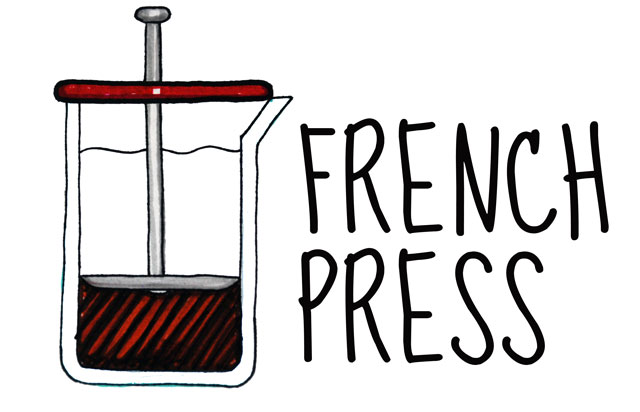
If you put coffee grounds and water together for a long enough time, some caffeinated intimacy is bound to happen. Cowboy coffee and Turkish coffee both do this, with the added risk of campfire injury and grounds stuck in your teeth. You can decrease the burn risk (to your coffee and your hand) by using a shock-resistant French press like Melisa (or try an insulated metal one) or a camping cone like Leah. Just pay attention to the clock because too much Water-Coffee Sexy Times will overextract your coffee, leaving you with harsh, bitter brew. You will need a larger supply of running water to clean the grounds from the mesh, so if you’re backpacking, you might want to think it out.
- Metal mesh is less forgiving than paper, so keep your grind coarse to reduce the floaties in your coffee. Improve the extraction by letting it steep.
- When you first pour your water, splash around so everything gets wet. Plus it’ll bubble up with some oily, rainbow foam!
- Swirl your carafe to break down the foam and increase Water-Coffee Sexy Times.
- Plunge slowly. Burning coffee burns.
Didn’t want a cheaper and uglier plastic press. Glass carafe is enclosed with a better insulated and more travel friendly santoprene/polycarbonate enclosure (as opposed to the typical metal frame). Bodum is a larger company and fairly well-known for their presses, replacable parts are easier to come across down the road. — Melisa
I brought a French press, used it once at camp — too hard to deal with the grounds. — Jeanette
I brought a little camping filter and mug. Lighter and less fragile than any of my other coffee makers. I’m a coffee snob. — Leah
LOVE my thermal stainless French press. Keeps it piping hot, v v easy. — Ann
Pressurized Methods
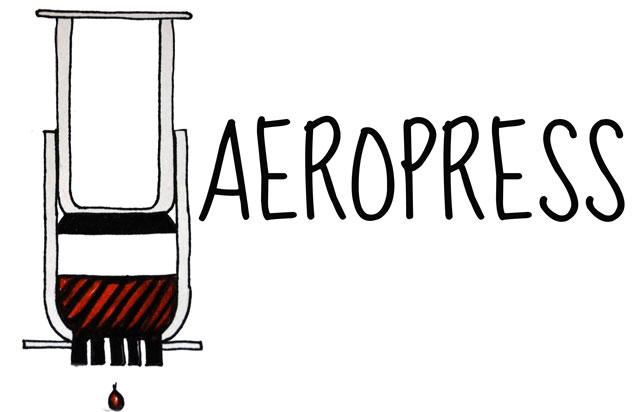
The caffeinating elephant tranquilizer syringe (aka Aeropress) is my weapon of choice when I’m arming myself in the woods and/or kitchen. It’s small and plastic and arrives in its own handy dandy carrying satchel! Taking a cue from Clover Coffee (RIP), it’s a pressurized French press, but on a smaller scale than those bulky $11,000 machines. You steep your grounds to your desired strength before plunging to emulsify the oils and form that tasty, tasty crema. The resulting coffee is thick and dark like espresso, but you can dilute as you see fit. And clean up? Unscrew the perforated plate and plunge away your coffee cake.
- You will be doing a shorter extraction than a French press, so you can start with a medium grind instead of coarse. You can choose to go fine or espresso ground and prevent oversteeping by plunging faster.
- Make sure to stir the grounds and water to form a bit of an emulsion.
- Flip your plunger over, adding coffee, water and then the filter. That way all of the coffee will be steeped for the same time. Or at least, that’s what Cee and Stumptown tell me.
Super easy to pack (and light)! I just got it for camp and will be spending the next month screwing around with it, trying different variations. But for $30 you can’t go wrong really. Best coffee I made at home by far. — Cee
Coffee Crystals
Turn your snob setting to low my friends! I am a fan of instant coffee. Coffee crystals are often maligned as an insipid beverage best left for children and people without standards, but they don’t have to be! One of my favourite exhibits at the VAG included Instant Coffee, a piece centralized around the idea that invented imitations don’t need to exist in the shadow of their inspiration. Think about it, you can wake up from something you stored in your pocket! What century are we in? So when you tear open a packet of granules, you don’t need to compare it to the fair trade soy flat white you had earlier that week, but simply recognize it as the warm beverage that perks you up enough to pee in the woods without tripping over your own feet.
Starbucks pioneered their super special instant coffee a few years ago and it actually manages to be a decent imitation of its drip offerings. But I feel weird spending that much money and prefer to go the roughing it financially. If you’re a Double Double kind of person and know you like your morning to taste like candy, you have options! I will always have a soft spot for the 3-in-1 coffee/sugar/whitener packets my mom picked up from Chinatown and Crystal carried hers all the way from Australia!
I always bring instant Nescafé single serve cappuccino sachets to A-Camp because I feel like they have a much higher caffeine content than the coffee machine stuff and I can drink multiple cups without getting a stomach ache. It’s the only strong instant coffee solution I’ve found in Australia that comes in super durable plastic packets that won’t explode in my suitcase. Honestly, this coffee doesn’t taste amazing, or really anything like a cappuccino – but it is available in Extra Strong and for me, caffeine content trumps flavour every time. I gave some of this coffee to Marni who rated it a 4/10, and then lowered it to a 2/10 once she left it sitting long enough for weird lumps to form. I personally give it a 5/10 for taste and a 10/10 for convenience. — Crystal
So what say you A-Campers? Were you satisfied with Alpine Meadows’ offerings or will you be doing something different come October? How do You Brew You?





